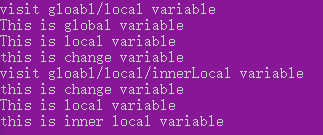06慕课网《进击Node.js基础(一)》作用域和上下文
作用域
function(){}大括号中的内容是一个作用域;
function 和 var 的声明会被提到作用域的最上面
function f(){ a = 2; var b = g(); //此处可以访问到g()函数 a=3; return b; function g(){ //函数的声明会被提前到作用域顶部 return a; } a=1; } var result = f(); console.log(f()); //2 console.log(a) //3 a未被声明,那么就会在全局作用域被声明; // 如果a被在f()中声明,那么全局作用域则访问不到 // 如果a在全局和局部作用域都被声明:那么两个a互相不干扰
调用函数访问变量的能力
//全局变量 var globalVariable = 'This is global variable' //全局函数 function globalFunction(){ //局部变量 var localVariable = 'This is local variable' console.log('visit gloabl/local variable') console.log(globalVariable) console.log(localVariable) globalVariable = 'this is change variable' console.log(globalVariable) //局部函数 function loaclFunction(){ //局部变量 var innerLocalVariable = 'this is inner local variable' console.log('visit gloabl/local/innerLocal variable') console.log(globalVariable) console.log(localVariable) console.log(innerLocalVariable) } //作用域内可访问局部函数 loaclFunction() } //在全局不能访问局部变量和函数 globalFunction()

上下文
和this关键字有关,是调用当前可执行代码的对象的引用
this指向函数拥有者,只能在函数中使用
this指向构造函数
var pet = { words:'..', speak:function(){ console.log(this.words) console.log(this==pet) } } pet.speak()

this指向全局对象
function pet(words){ this.words = words console.log(this.words) console.log(this==global) } //this指向了全局global对象 pet('..')

this指向实例对象
function Pet(words){ this.words = words this.speak = function(){ console.log(this.words) console.log(this) } } var cat = new Pet('Miao') cat.speak();

使用call和apply改变上下文引用对象
this指向引用方法的对象
var pet = { words:'..', speak:function(say){ console.log(say + ' ' + this.words) } } pet.speak('haha')

使用call-apply
var pet = { words:'..', speak:function(say,free){ console.log(say + ' ' + free+ ' '+ this.words) } } var dog={ words:'wawa' } pet.speak.call(dog,'haha','lala') pet.speak.apply(dog,['haha','lala'])

使用call和apply方便实现继承
function Pet(words){ this.words = words this.speak = function(){ console.log(this.words) } } //Dog继承Pet,拥有了Pet的speak方法 function Dog(words){ Pet.call(this,words) } var dog = new Dog('wawa') dog.speak()



